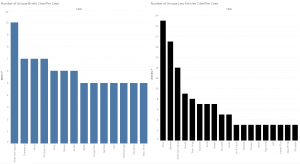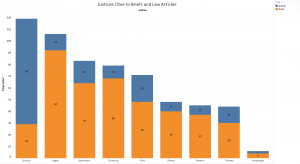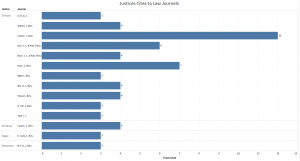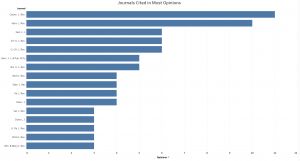Empirical SCOTUS: What the justices cited in OT 2018

on Jul 24, 2019 at 11:16 am

During the 2018 term, the Supreme Court heard 67 oral arguments leading to decisions. The justices’ opinions cited briefs filed in these cases and law articles approximately 601 times. These citations were from a total of approximately 330 briefs and articles. The citations were primarily clustered in certain cases. For instance, 30 cases, or about 45 percent, included citations to law articles. 58 decisions cited to briefs within those cases, equating to almost 87 percent of argued cases. Within this set of cases, certain decisions, opinions and justices cited to briefs and articles much more frequently than others.
Decisions
Citations were also not evenly distributed among decisions that contained them, as some had only a few while others had a multitude. The first figure shows the number of cites to unique briefs in these cases (only briefs filed at the Supreme Court level within that particular case) on the left and unique law articles (based on journal-name abbreviation) on the right. The graph for briefs shows cases with five or more unique briefs cited, and the graph for articles shows cases with three or more law articles cited.
Although briefs were cited in decisions in a much larger portion of the cases argued this term, more unique articles than briefs were cited in particular cases. American Legion v. American Humanist Association had the most cites to different briefs of the cases this term, with 10. Justice Ruth Bader Ginsburg’s dissent in the case had the most cites, followed by Justice Samuel Alito’s opinion for the court. After American Legion, the justices cited seven distinct briefs in three different cases — Department of Commerce v. New York, Knick v. Township of Scott, Pennsylvania and Virginia Uranium v. Warren.
Citations to law articles appear in several opinions in particular, with the most in Kisor v. Wilkie (23), Gamble v. United States (19), and American Legion (14). After these there is a significant drop-off to Gundy v. United States (9) and to the remaining decisions with three or more citations to law articles.
Justices
Several justices frequently cited briefs and law articles, although Justice Neil Gorsuch cited more than the rest in the aggregate — primarily citing law articles.
Gorsuch cited 119 combined briefs and articles, and his 90 cites to law articles far surpass those of any other justice, with Alito citing the second most at 23. Justice Elena Kagan cited more briefs than any other justice with 92; with 14 cites to law articles, Kagan’s total cite count comes in second of the justices, with 106. Justice Sonia Sotomayor had the third most overall cites with 83, followed by Ginsburg at 79 and Alito at 71.
The next figure picks apart the distribution of cites to law articles by looking at when justices cited individual law journals three or more times. These cites may have been in the same or in different cases.
The majority of Gorsuch’s cites to law reviews were in Kisor v. Wilkie, in which he cited them 48 times. Breaking these down by individual cases and law journals, Gorsuch cited Columbia Law Review seven times in Kisor, three times in Gamble, once in Gundy and once in United States v. Haymond. Gorsuch’s seven cites to Harvard Law Review articles come in Kisor (4), Tennessee Wine & Spirits Retailers Association v. Thomas (2), and Bucklew v. Precythe (1). Ginsburg’s four cites to Columbia Law Review were all in Gamble.
Top-cited law journals
The justices looked to specific law journals for the bulk of citations this term as well. The following figure looks at journals that were uniquely cited in the most total opinions this term. This method counts cites from multiple opinions in the same cases as multiple unique cites.
Columbia Law Review was cited in 11 opinions this term, the most among law journals. Harvard Law Review was one opinion cite behind with 10. Georgetown Law Journal, NYU Law Review and University of Chicago Law Review all were cited in six opinions this term; Northwestern University Law Review and Harvard’s Journal of Law and Public Policy were cited in five opinions apiece.
These citations numbers are in line with what we have seen in part terms for law journals and for briefs. Substantial variation exists between the justices’ individual practices and between the utility of these sources for different cases. Along with looking at the briefs and journals cited most frequently, another interesting layer to these data deals with why such cites are so important in particular cases relative to others. Whether the reason has to do with the relationship between certain case issues and the legal academy’s views or between certain cases and the positions and facts relayed in the briefs, the justices certainly do not cite these sources evenly across opinions. Understanding these variations could prove quite helpful in informing practitioners’ strategic brief-writing choices moving forward.






